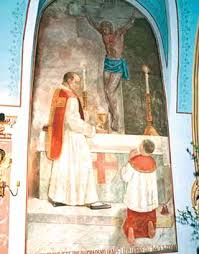The Guardian Angel: Eucharistic Miracle 1532, Marseille France
- Donald Hartley

- Mar 23, 2020
- 4 min read

In 1533, some thieves stole a ciborium containing some consecrated Hosts from a church. The thieves then discarded the Hosts in a field. Unfortunately there was a strong snow storm; however, the following day the Hosts were recovered and miraculously were found to be in perfect condition. The numerous healings and the tremendous popular devotion that followed the miracle were not sufficient to protect the Hosts, which were destroyed by some seeking to profane them.
In the year 1532, toward the end of the month of December, thieves entered the parish church of Marseille en Beauvais and stole a precious silver ciborium that contained consecrated Hosts. The Hosts were abandoned under a large rock along a main street.
The first day of January, Mr. Jean Moucque was walking down that street despite a strong snow storm. While he was walking, a rock on the side of the road captured his attention, because it did not have any snow on it. When he lifted the rock, he was amazed to find the Hosts completely intact.

He immediately told the pastor, Father Prothais, who, accompanied by many of the faithful, carried the Hosts into the parish church. They placed a cross on the location where the Hosts were found, and in order to accommodate the large number of devoted faithful who would come to visit, eventually built the Chapel of the Sacred Hosts.
The Lord worked many miracles at this chapel. The historian, Pierre Louvet describes some of these miracles in his Histoire de la Ville de Beauvais. There was the extraordinary story of the priest, Father Jacques Sauvage, who was completely healed after being paralyzed and having lost his ability to speak. Mr. d’Autreche, blind from birth, regained his sight.
Despite all of these graces given by God, the Bishop-Count of Beauvais, Odet de Coligny, converted to Calvinism and married Elizabeth of Hauteville. Before publicly renouncing his faith, he ordered the Hosts to be consumed. Today, the Chapel of the Sacred Hosts still stands and every year on the Second day of January, a Solemn Mass is celebrated in honor of the miracle of 1533.

The Eucharistic Miracles
Eucharistic miracles are God's extraordinary interventions, meant to confirm faith in the real presence of the body and blood of the Lord in the Eucharist. We know the Catholic teaching on the real presence. With the words of consecration:
"This is my body," "This is my blood," the substance of bread becomes the body of Christ, and the substance of wine His blood. This marvelous change is called transubstantiation, that is to say, the passage of substance.
Of the bread and wine there remain only the appearances or species, which, with a philosophical term, are called accidents. In other words, only the dimensions, color, taste, smell and even the nutritive capacity remain. But the substance, that is to say, the true reality does not remain, for it has become the body and blood of the Lord.
Transubstantiation can in no way be experienced by the senses; only faith assures us of this marvelous change.
The Eucharistic miracles are meant to confirm this faith, which is based on Jesus's words according to which what seems like bread is no longer bread, and what seems wine is no longer wine. In fact, in the Eucharistic miracles the flesh and blood—or one or the other—appear, depending on the situation. The purpose of these miracles is to show that we must not look at the external appearance (bread and wine) but at the substance, to the true reality of the thing, which is flesh and blood.

Medieval theologians have carefully examined the matter of Eucharistic Miracles (which were very frequent in their day) and have given various interpretations; but the best founded and most reasonable one seems to be that of St. Thomas Aquinas, the “Eucharistic Doctor” par excellence (Summa Theolgica III, q. 76, a. 8).
He says that the body and blood which appear after a miracle are due to the transformation of the Eucharistic species, namely, of the accidents, and do not touch the true substance of the body and blood of Christ. In other words, the species of bread and wine are miraculously changed into the species of flesh and blood; but the true body and true blood of Jesus are not those which appear but those which, even before the miracle, were hidden beneath the species of flesh and blood.
If, in fact, the flesh and blood which appear were truly the flesh and blood of Christ, we would have to say that the risen Jesus, who reigns impassibly at the right hand of the Father, loses a part of his flesh and blood, something which in no way can be accepted.
We must therefore say that the flesh and blood which appear in the miracles are in the order of species or appearances, neither more nor less than the order of the species of bread and wine.
The Lord performs these miracles to give us a sign, easy and visible to all, that in the Eucharist there is the true body and true blood of the Lord.

But this true body and this true blood are not those that appear, but rather those that are substantially contained under the species or appearances, species and appearances that, before the miracle, were those of bread and wine, and after the miracle are those of flesh and blood.
Under the appearances of flesh and blood Jesus is truly and substantially contained as He was before the miracle.
For this reason we can adore Jesus truly present under the species of flesh and blood.
Father Roberto Coggi, O.P.





















Comments